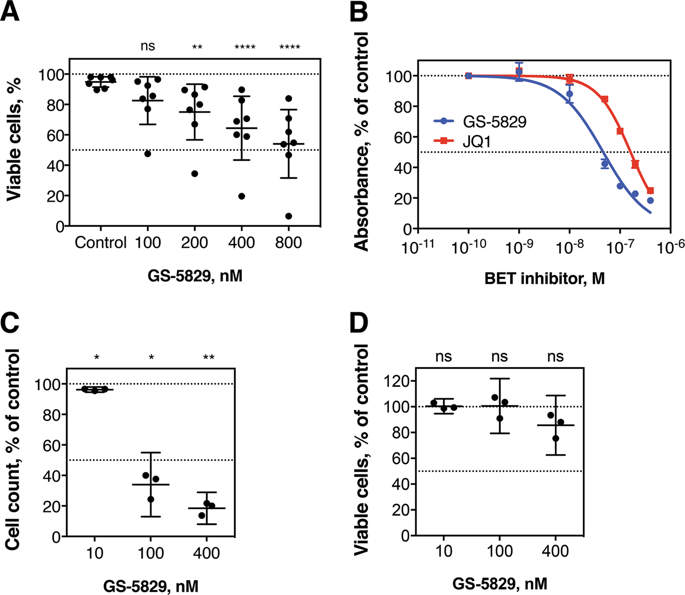Our official English website, www.x-mol.net, welcomes your feedback! (Note: you will need to create a separate account there.)
The BET inhibitor GS-5829 targets chronic lymphocytic leukemia cells and their supportive microenvironment.
Leukemia ( IF 11.4 ) Pub Date : 2019-12-20 , DOI: 10.1038/s41375-019-0682-7 Ekaterina Kim 1 , Elisa Ten Hacken 2 , Mariela Sivina 1 , Astrid Clarke 3 , Philip A Thompson 1 , Nitin Jain 1 , Alessandra Ferrajoli 1 , Zeev Estrov 1 , Michael J Keating 1 , William G Wierda 1 , Kapil N Bhalla 1 , Jan A Burger 1
Leukemia ( IF 11.4 ) Pub Date : 2019-12-20 , DOI: 10.1038/s41375-019-0682-7 Ekaterina Kim 1 , Elisa Ten Hacken 2 , Mariela Sivina 1 , Astrid Clarke 3 , Philip A Thompson 1 , Nitin Jain 1 , Alessandra Ferrajoli 1 , Zeev Estrov 1 , Michael J Keating 1 , William G Wierda 1 , Kapil N Bhalla 1 , Jan A Burger 1
Affiliation

|
Despite major improvements in treatment outcome with novel targeted therapies, such as the Bruton tyrosine kinase (BTK) inhibitor ibrutinib, chronic lymphocytic leukemia (CLL) remains incurable in the majority of patients. Activation of PI3K, NF-κB, and/or MYC has been linked to residual disease and/or resistance in ibrutinib-treated patients. These pathways can be targeted by inhibitors of bromodomain and extra-terminal (BET) proteins. Here we report about the preclinical activity of GS-5829, a novel BET inhibitor, in CLL. GS-5829 inhibited CLL cell proliferation and induced leukemia cell apoptosis through deregulation of key signaling pathways, such as BLK, AKT, ERK1/2, and MYC. IκBα modulation indicates that GS-5829 also inhibited NF-κB signaling. GS-5829-induced apoptosis resulted from an imbalance between positive (BIM) and negative regulators (BCL-XL) of the intrinsic apoptosis pathway. The antileukemia activity of GS-5829 increased synergistically in combinations with B-cell receptor signaling inhibitors, the BTK inhibitor ibrutinib, the PI3Kδ inhibitor idelalisib, and the SYK inhibitor entospletinib. In cocultures that mimic the lymph node microenvironment, GS-5829 inhibited signaling pathways within nurselike cells and their growth, indicating that BET inhibitors also can target the supportive CLL microenvironment. Collectively, these data provide a rationale for the clinical evaluation of BET inhibitors in CLL.
中文翻译:

BET抑制剂GS-5829靶向慢性淋巴细胞性白血病细胞及其支持性微环境。
尽管使用新型靶向疗法(例如Bruton酪氨酸激酶(BTK)抑制剂依鲁替尼)在治疗结果方面取得了重大改善,但大多数患者仍无法治愈慢性淋巴细胞性白血病(CLL)。PI3K,NF-κB和/或MYC的激活与依鲁替尼治疗患者的残余疾病和/或耐药性相关。溴结构域和末端外(BET)蛋白抑制剂可靶向这些途径。在这里,我们报道了一种新的BET抑制剂GS-5829在CLL中的临床前活性。GS-5829通过失活关键信号通路(例如BLK,AKT,ERK1 / 2和MYC)来抑制CLL细胞增殖并诱导白血病细胞凋亡。IκBα调节表明GS-5829也抑制NF-κB信号传导。GS-5829诱导的细胞凋亡是由于内在细胞凋亡途径的正调节剂(BIM)和负调节剂(BCL-XL)之间不平衡所致。GS-5829的抗白血病活性与B细胞受体信号传导抑制剂,BTK抑制剂依鲁替尼,PI3Kδ抑制剂依德利西伯和SYK抑制剂恩斯普列替尼协同增效。在模仿淋巴结微环境的共培养物中,GS-5829抑制了护士样细胞内的信号通路及其生长,这表明BET抑制剂也可以靶向支持性CLL微环境。总的来说,这些数据为CLL中BET抑制剂的临床评估提供了依据。BTK抑制剂依鲁替尼,PI3Kδ抑制剂艾达拉西布和SYK抑制剂恩斯普替尼。在模仿淋巴结微环境的共培养物中,GS-5829抑制了护士样细胞内的信号通路及其生长,这表明BET抑制剂也可以靶向支持性CLL微环境。总的来说,这些数据为CLL中BET抑制剂的临床评估提供了依据。BTK抑制剂依鲁替尼,PI3Kδ抑制剂艾达拉西布和SYK抑制剂恩斯普替尼。在模仿淋巴结微环境的共培养物中,GS-5829抑制了护士样细胞内的信号通路及其生长,这表明BET抑制剂也可以靶向支持性CLL微环境。总体而言,这些数据为CLL中BET抑制剂的临床评估提供了依据。
更新日期:2019-12-20
中文翻译:

BET抑制剂GS-5829靶向慢性淋巴细胞性白血病细胞及其支持性微环境。
尽管使用新型靶向疗法(例如Bruton酪氨酸激酶(BTK)抑制剂依鲁替尼)在治疗结果方面取得了重大改善,但大多数患者仍无法治愈慢性淋巴细胞性白血病(CLL)。PI3K,NF-κB和/或MYC的激活与依鲁替尼治疗患者的残余疾病和/或耐药性相关。溴结构域和末端外(BET)蛋白抑制剂可靶向这些途径。在这里,我们报道了一种新的BET抑制剂GS-5829在CLL中的临床前活性。GS-5829通过失活关键信号通路(例如BLK,AKT,ERK1 / 2和MYC)来抑制CLL细胞增殖并诱导白血病细胞凋亡。IκBα调节表明GS-5829也抑制NF-κB信号传导。GS-5829诱导的细胞凋亡是由于内在细胞凋亡途径的正调节剂(BIM)和负调节剂(BCL-XL)之间不平衡所致。GS-5829的抗白血病活性与B细胞受体信号传导抑制剂,BTK抑制剂依鲁替尼,PI3Kδ抑制剂依德利西伯和SYK抑制剂恩斯普列替尼协同增效。在模仿淋巴结微环境的共培养物中,GS-5829抑制了护士样细胞内的信号通路及其生长,这表明BET抑制剂也可以靶向支持性CLL微环境。总的来说,这些数据为CLL中BET抑制剂的临床评估提供了依据。BTK抑制剂依鲁替尼,PI3Kδ抑制剂艾达拉西布和SYK抑制剂恩斯普替尼。在模仿淋巴结微环境的共培养物中,GS-5829抑制了护士样细胞内的信号通路及其生长,这表明BET抑制剂也可以靶向支持性CLL微环境。总的来说,这些数据为CLL中BET抑制剂的临床评估提供了依据。BTK抑制剂依鲁替尼,PI3Kδ抑制剂艾达拉西布和SYK抑制剂恩斯普替尼。在模仿淋巴结微环境的共培养物中,GS-5829抑制了护士样细胞内的信号通路及其生长,这表明BET抑制剂也可以靶向支持性CLL微环境。总体而言,这些数据为CLL中BET抑制剂的临床评估提供了依据。


























 京公网安备 11010802027423号
京公网安备 11010802027423号